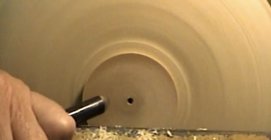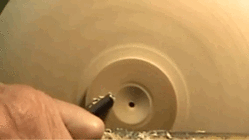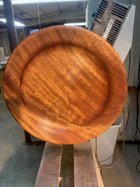-
December 2025 Turning Challenge: Single Tree! (click here for details) -
Congratulations to Bob Henrickson, People's Choice in the November 2025 Turning Challenge (click here for details) -
Congratulations to Guillaume Fontaine for "Old Tea Pot" being selected as Turning of the Week for December 15, 2025 (click here for details) -
Welcome new registering member. Your username must be your real First and Last name (for example: John Doe). "Screen names" and "handles" are not allowed and your registration will be deleted if you don't use your real name. Also, do not use all caps nor all lower case.
You are using an out of date browser. It may not display this or other websites correctly.
You should upgrade or use an alternative browser.
You should upgrade or use an alternative browser.
Endgrain tearout in transition
- Thread starter Holmes Anderson
- Start date
A standard scraper and/or a NRS will do a fine job sweeping across the bottom of a platter. However, when going through the transition area, since they are both scrapers, you will still get some tear out. I prefer a shear scrape, which generally will leave the least amount of tear out. Do check out my shear scraping video on You Tube. With different woods, you will get different results, and this is even with blanks from the same tree. Generally, harder woods will result in slightly less tear out than softer woods. Sugar/hard maple and big leaf maple yield much different results.... A NRS, freshly sharpened, and taking several passes, and probably sharpening each time will get the job done as well. I do prefer a burnished burr for my shear scraping.
robo hippy
robo hippy
Thanks Reed. Is there a video specifically on shear scraping or is it part of the scraper video that covers roughing? I guess I can look at the list on the channel and figure it out. I was using a grinder burr that seemed to be cutting well but the problems really popped out as soon as the finish was applied. Seems fixable.
Ok, the video was easier to find than I expected. Looks like a 1-1/2" round nose is a good place to start. Interesting that it works without grain support.
Ok, the video was easier to find than I expected. Looks like a 1-1/2" round nose is a good place to start. Interesting that it works without grain support.
Last edited:
can’t help since tear out is also my nemesis. Sharp tools and higher rpm help. Pretty platter!
Scary Scrapers is about using scrapers for roughing, at least mostly. The shear scraping one is all about that skill. I don't like big heavy scrapers, just too much metal.
robo hippy
robo hippy
That's a really tough situation you have, Holmes. The transition section is short and steep, maybe too much so to get a 1 1/2" scraper applied, even on edge. If I understand correctly, shear scraping is not supposed to require going 'downhill' with the grain to get a good surface, but using a NRS or regular scraper working downhill might make a difference sometimes. As Reed noted, the type of wood, sometimes the individual piece of wood, makes a difference, too. If you can get a smallish gouge with a sharp, not too pointy edge oriented just right, with continuous bevel contact and a shear angle, cutting the wood cleanly downhill can produce a tear out free surface, but all those requirements and gyrations make it a real challenge. Everybody but Odie resorts to the 80 grit gouge now and then.
Last edited:
I went after it with a 1/2" round nose scraper in shear and it helped quite a bit. Not perfect, but much better. Having some oil in the fibers probably helped too. In general, a 1-1/2" scraper is probably too big and thick for most transitions and the 1/2" is too small and thin - it chatters from a light breeze. I'm buying a 1" round nose scraper that I hope will make a better general purpose interior shear scraping tool. I have one foot in the Odie camp when it comes to sanding. On flat work I have a strong preference for finishing with a bench plane.
- Joined
- Apr 27, 2004
- Messages
- 9,306
- Likes
- 6,062
- Location
- Lakeland, Florida
- Website
- www.hockenberywoodturning.com
That is a tough spot. Too tight for most scrapers.
I would try my small bowl gouge 3/8 dia bar with a Michelson grind.
If that did’t get a clean cut I’d try a Hunter carbide.
Softer woods like Sapele can be hard to scrape well.
I would try my small bowl gouge 3/8 dia bar with a Michelson grind.
If that did’t get a clean cut I’d try a Hunter carbide.
Softer woods like Sapele can be hard to scrape well.
I only have two bowl gouges - 1/2" M2 with a 40/40 grind and a Hunter Hercules. I like the versatility of the Hunter tool. It is my bottom gouge, roughing gouge, and hollowing tool. The one thing I dislike about the Hunter tool is the shallow V angle of the cutter to the holder bevel. I was puzzled by that geometry until I realized that most turners sharpen on a bench grinder and get a hollow grind. I assume the shallow V on the Hunter mimics the hollow of an 8" wheel. I have been sharpening with narrow sanding belts for 20+/- years so I am accustomed to a dead flat bevel. The hollow grind feels different when riding the bevel - like riding the heel (on the short bevel of the Hunter) instead of the flat just behind the cutting edge. Anyway, the transition in that platter was shaped with a Hunter tool and the leftover ripples were cleaned up with a scraper using a scrape cut, which tore the endgrain. The shear scrape seems to be the answer to cleaning up the ripples leftover from the gouges. If I was brave, then I could try a 3/8" spindle gouge but my guess is that would end badly.That is a tough spot. Too tight for most scrapers.
I would try my small bowl gouge 3/8 dia bar with a Michelson grind.
If that did’t get a clean cut I’d try a Hunter carbide.
Softer woods like Sapele can be hard to scrape well.
- Joined
- Apr 27, 2004
- Messages
- 9,306
- Likes
- 6,062
- Location
- Lakeland, Florida
- Website
- www.hockenberywoodturning.com
The 40/40 is great for convex surfaces but doesn’t do well on concave curves.
You are trying to make an ogee curve from rim to bottom.
@john lucas has a nice video on the Hercules. Search “John Luca Hercules” it should pop up.
Watch how he turns the tenon and also how he rotates the tool to ride the bevel.
You could practice with scrap wood to see if you can ride the bevel through that ogee.
A 3/8 gouge with a convex bevel will let you ride the bevel making a clean
You could regrind a spindle gouge to convex bevel and make it work.
Also a detail gouge with a 60 degree bevel might do it nicely.
If you want to do this ogee curve a lot you might consider acquiring a 3/8 diameter bowl gouge with a convex bevel.
This isn’t an ogee but it will give you an idea of how it works.
A look at the convex bevel…………..using it to shape an seed jar opening in the tenon.


You are trying to make an ogee curve from rim to bottom.
@john lucas has a nice video on the Hercules. Search “John Luca Hercules” it should pop up.
Watch how he turns the tenon and also how he rotates the tool to ride the bevel.
You could practice with scrap wood to see if you can ride the bevel through that ogee.
A 3/8 gouge with a convex bevel will let you ride the bevel making a clean
You could regrind a spindle gouge to convex bevel and make it work.
Also a detail gouge with a 60 degree bevel might do it nicely.
If you want to do this ogee curve a lot you might consider acquiring a 3/8 diameter bowl gouge with a convex bevel.
This isn’t an ogee but it will give you an idea of how it works.
A look at the convex bevel…………..using it to shape an seed jar opening in the tenon.



